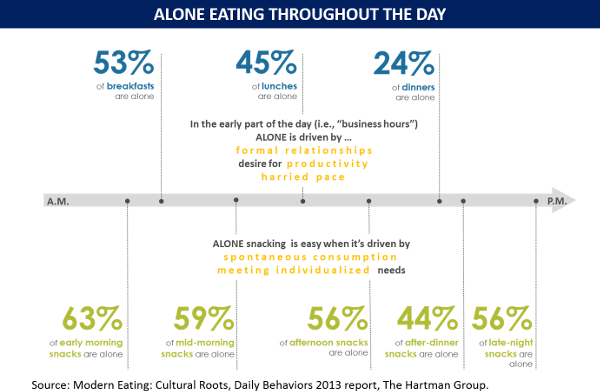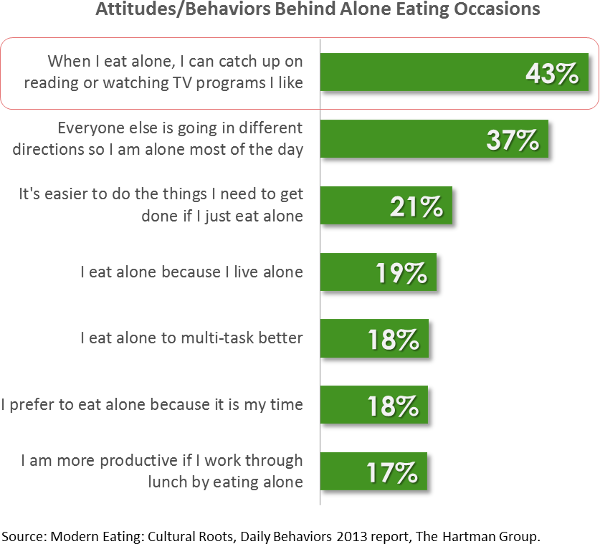EVOLVING TREND IN EATING OCCASIONS: “ALL BY MYSELF”
 How we eat in America today is a reflection of the continued erosion of ritual, and nothing is more powerful proof of this than just how much of our collective eating occasions happen alone. We are eating more and more alone; we are prioritizing non-ritualized snacking over meals; and as household sizes are getting smaller, mealtime ritual is harder to sustain interest in.
How we eat in America today is a reflection of the continued erosion of ritual, and nothing is more powerful proof of this than just how much of our collective eating occasions happen alone. We are eating more and more alone; we are prioritizing non-ritualized snacking over meals; and as household sizes are getting smaller, mealtime ritual is harder to sustain interest in.
The numbers around eating alone are nothing short of revelatory. As you will see, they illustrate why we’ve been saying for quite some time now that alone eating is the new norm.
You may recall our past references to the notion that our food and beverage culture is evolving from a traditional, status quo culture to one that is reimagined, consumer driven and experiential. The one standout example of this is the way in which many of us eat today, which is that nearly half of all adult eating occasions are completely alone (46 percent, according to The Hartman Group’s Food & Beverage Occasions Compass 2014 data).
Alone eating no longer connotes physical and social isolation. As consumers continue to redefine the concept of “meal,” alone eating has become a normal part of modern life. In certain settings (such as the workplace), alone eating has become so pervasive that many of us don’t realize we’re doing it — underscoring the ubiquitous behavior that solitary eating has become.
The rise of alone eating has emerged from a number of trends:
- Transitions within households post-World War II. The decades after WWII saw the movement of mothers into the workforce, the rise of single-parent households and the rise of technology (e.g., television), all of which made inroads into traditional, social, sit-down "family meals."
- A gradual loss of focus over the past fifty years on the importance of dining communally during specific meal occasions. Consider the now nearly forgotten practice of workers and schoolchildren returning home midday for family lunches or the increasingly rare “family dinner.”
- A continual movement away from a focus on taking time to consume foods. In modern culture, many meal occasions, especially those that are solitary, are now characterized by the mechanics of eating and not the celebration of food occasions. A common example is the now-pervasive practice of Americans eating alone at their desks while they work.
- The snackification of meals. America is now a snacking culture where eating any time of day is a personal right and satiety is often the goal. Consumers increasingly believe that eating smaller meals more frequently is healthier and that snacking bridges gaps between meals due to long work and commute times.
- Shifts in shopping behavior. Consumers today shop more channels and more stores to satisfy a number of needs, to explore and to get value. Thus they are assigning specific roles to stores that are well-positioned to meet "in-the-moment desires" (e.g., 'my P.M. snack spot,' 'grab-n-go dinner spot'). Overall, stock-up grocery shopping trips are declining as consumers try to "shop fresh."
How We Eat: Alone Eating by the Numbers
The following chart illustrates how alone eating occasions transition from meals to earlier in the day to snacking alone throughout the day.

The reasons for alone eating are complex and diverse. Another common development is the household where on many occasions everybody eats alone. Obviously, part of this is driven by so-called “hectic” schedules and the increasing fragmentation of daily life, but in many other cases this happens simply by choice. The pantry and kitchen serve as a sort of 24-hour commissary for all to access at will, save for the rare and special occasions during which all gather to eat collectively.
The following chart depicts seven key attitudes and/or behaviors behind alone eating occasions. As you can see, the top reasons consumers use alone eating is to recharge and indulge in “me time.”

Alone Eating: Connecting With More Than a Solitary Consumer
In the bygone era that represents traditional food culture, the proverbial frozen dinner was the primary solution for alone and semi-alone eating. Today’s forward-leaning retailers are providing solutions for consumers with single-serve and customizable options with global freshness cues.
CPG food manufacturers can connect with consumers relevantly by creating new forms of packaging and ingredients that encourage interactivity and a sense of personalization. Trader Joe’s is often praised by consumers for its two-person meal solutions.
Consumers are cooking for themselves on alone occasions. This is an opportunity for food retailers to provide the meal components they need to enjoy this occasion.
Food retailers can connect with those shoppers looking for prepared, single-portion meals for one, prepared foods by constructing food service, ready-to-go hot and refrigerated stations (a la Whole Foods Market and Wegmans). This provides shoppers the flexibility to mix-and-match new tastes and cuisines.
Culture is redefining what alone eating has to be. Alone eating today now includes reimagined ways of connecting with people, ourselves and food and beverage. Rather than marketing to family occasions and iconic meals of the past, new opportunity spaces exist to market to the vast number of adults who are increasingly eating alone.
Resources: Reports
